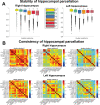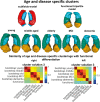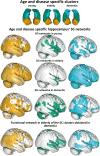Hippocampus co-atrophy pattern in dementia deviates from covariance patterns across the lifespan
- PMID: 32851402
- PMCID: PMC7523701
- DOI: 10.1093/brain/awaa222
Hippocampus co-atrophy pattern in dementia deviates from covariance patterns across the lifespan
Abstract
The hippocampus is a plastic region and highly susceptible to ageing and dementia. Previous studies explicitly imposed a priori models of hippocampus when investigating ageing and dementia-specific atrophy but led to inconsistent results. Consequently, the basic question of whether macrostructural changes follow a cytoarchitectonic or functional organization across the adult lifespan and in age-related neurodegenerative disease remained open. The aim of this cross-sectional study was to identify the spatial pattern of hippocampus differentiation based on structural covariance with a data-driven approach across structural MRI data of large cohorts (n = 2594). We examined the pattern of structural covariance of hippocampus voxels in young, middle-aged, elderly, mild cognitive impairment and dementia disease samples by applying a clustering algorithm revealing differentiation in structural covariance within the hippocampus. In all the healthy and in the mild cognitive impaired participants, the hippocampus was robustly divided into anterior, lateral and medial subregions reminiscent of cytoarchitectonic division. In contrast, in dementia patients, the pattern of subdivision was closer to known functional differentiation into an anterior, body and tail subregions. These results not only contribute to a better understanding of co-plasticity and co-atrophy in the hippocampus across the lifespan and in dementia, but also provide robust data-driven spatial representations (i.e. maps) for structural studies.
Keywords: dementia; elderly; parcellation; structural covariance; temporal lobe.
© The Author(s) (2020). Published by Oxford University Press on behalf of the Guarantors of Brain.
Figures




References
-
- Amaral RSC, Park MTM, Devenyi GA, Lynn V, Pipitone J, Winterburn J, et al. Manual segmentation of the fornix, fimbria, and alveus on high-resolution 3T MRI: application via fully-automated mapping of the human memory circuit white and grey matter in healthy and pathological aging. Neuroimage 2018; 170: 132–50. - PubMed
-
- Bi G, Poo M. Distributed synaptic modification in neural networks induced by patterned stimulation. Nature 1999; 401: 792–6. - PubMed

